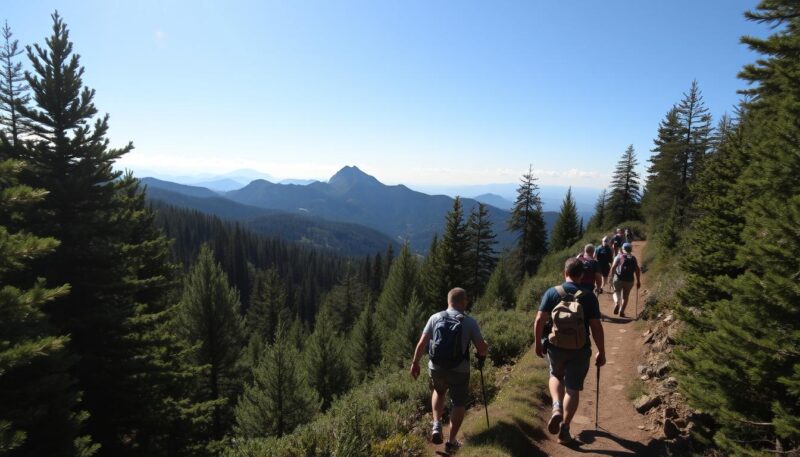Did you know over 42 million Americans hiked in 2020? This shows how much people love outdoor adventures. But, there’s a big difference between trekking and hiking that many miss.
Trekking means long, tough trips through rough places. It needs lots of stamina and planning. Hiking, on the other hand, is shorter and easier. It’s for people of all fitness levels and can be done in one day.
This article will explore the key differences between trekking and hiking. We’ll see how each activity adds to our love for nature.
Understanding Hiking
Hiking is a fun outdoor activity that connects us with nature and keeps us fit. It involves walking on trails, making it easy for everyone to enjoy. This section will explore what makes hiking special and the different types of hiking out there.
Definition and Characteristics
Hiking is about walking in nature, from easy paths to tough terrains. Key traits of hiking include:
- Accessibility: You don’t need much gear, making it great for beginners.
- Shorter Duration: Hikes usually last a few hours to a whole day.
- Physical Demand: It’s not too hard, but you need some fitness based on the trail.
Types of Hiking
There are many types of hiking for different interests and skills. Some popular ones are:
- Day Hiking: Perfect for a quick outdoor adventure.
- Backpacking: Combines hiking with camping, for longer trips with overnight stays.
- Wilderness Hiking: For the brave, it offers remote areas and solitude for seasoned hikers.
Introduction to Trekking
Trekking is a unique outdoor adventure that stands out from other activities. It’s a demanding journey over several days, often on unmarked trails. These paths wind through diverse, untamed landscapes. It’s a challenge that tests both body and mind.
Definition and Characteristics
For those thinking about trekking, it’s important to know what it’s all about. It demands physical strength and mental toughness. You’ll face various terrains and need to stay focused.
- Duration: Trekking can last from a few days to weeks, giving you time to enjoy nature fully.
- Terrain: You’ll explore rugged areas like mountains, deserts, and forests. It’s a chance to get up close to nature.
- Physical Requirement: Trekking is tough, so you need to be in good shape. Preparation is key.
Types of Trekking
There are many types of trekking, each suited to different interests and skill levels. Here’s a look at some popular ones:
| Type of Trekking | Description | Ideal For |
|---|---|---|
| Backpacking Trekking | You carry all your gear for days, needing to know how to navigate. | Adventurers who want to be self-sufficient. |
| Lodging Trekking | Includes staying at lodges or camps, offering more comfort. | Those who want adventure but also comfort. |
| Expedition Trekking | Long, tough journeys in extreme places, needing expert guides. | Experienced trekkers looking for big challenges. |
Trekking offers a wide range of experiences for outdoor enthusiasts. It’s a great choice for those who love exploring the great outdoors.
Trekking vs Hiking: What Sets Them Apart
Hiking and trekking differ in how long they last and how hard they are. Hiking is usually shorter and follows marked trails. Trekking, on the other hand, covers longer distances and varied terrains. Knowing these differences helps people pick the right path based on their fitness and time.
Duration and Intensity
Hiking is a few hours long, making it good for people of all fitness levels. Trekking, however, is much longer, lasting days or even weeks. The difficulty of hiking trails can vary, from easy day hikes to very challenging ones.
Trekking often means camping overnight, which requires more stamina because of the long, hard trails.
Gear and Preparation
Choosing the right gear is key for both hiking and trekking. For hiking, you need light stuff like daypacks, water bottles, and good shoes. Trekking, however, needs more serious gear, like strong backpacks, big first-aid kits, and clothes that can handle the weather.
Preparing for trekking means planning more, making sure you have enough supplies for the long journey.
| Aspect | Hiking | Trekking |
|---|---|---|
| Duration | Hours | Days to months |
| Intensity | Varies, generally moderate | High endurance required |
| Gear Needed | Lightweight, basic | Heavy-duty, specialized |
| Preparation | Minimal | Extensive planning required |
Conclusion
Understanding the difference between trekking and hiking is key for those who love the outdoors. Trekking is for the bold, offering long, challenging paths. Hiking, on the other hand, is perfect for those who want to connect with nature easily, needing little gear and time.
Both activities boost outdoor fun, helping you see nature’s beauty and stay fit. Trekking is for those who love long adventures, needing to be ready for days. Hiking is great for quick nature breaks. Either way, you’ll grow to love the environment more, feeling more mindful and well.
Both trekking and hiking add value to outdoor life. They help us connect with nature, leading to a healthier, more aware lifestyle. Whether you choose trekking or hiking, you’ll find joy and growth in the great outdoors.



